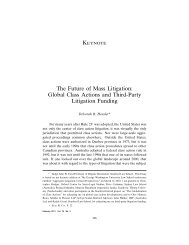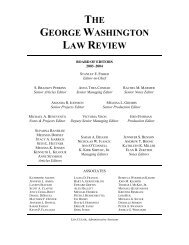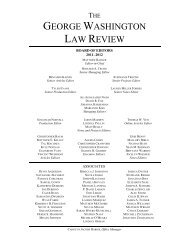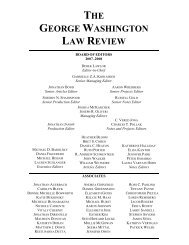View PDF - The George Washington Law Review
View PDF - The George Washington Law Review
View PDF - The George Washington Law Review
You also want an ePaper? Increase the reach of your titles
YUMPU automatically turns print PDFs into web optimized ePapers that Google loves.
2010] Oral History and the Study of the Judiciary 855<br />
said what they did and took certain positions and sometimes spelling<br />
out where interviewer and interviewee did not agree.” 46<br />
II.<br />
<strong>The</strong> Oral Histories of Judge Thomas Fairchild<br />
To get a better sense for what judicial oral histories have to offer,<br />
I took an independent look at the oral histories of Judge Thomas<br />
Fairchild, who served as a justice on the Wisconsin Supreme Court<br />
from 1957 until 1966, and then as a judge on the Seventh Circuit from<br />
1966 until 2007. 47 As it turns out, Judge Fairchild sat for at least three<br />
such histories. <strong>The</strong> first was taken in 1985, by the Wisconsin Historical<br />
Society as part of its Wisconsin Democratic Party Oral History Project.<br />
48 <strong>The</strong> second, which Domnarski read and references in his book,<br />
was conducted in 1992 by Collins Fitzpatrick, the Circuit Executive of<br />
the Seventh Circuit. 49 <strong>The</strong> third interview took place in 1998, in connection<br />
with the “Justice in <strong>The</strong>ir Own Words” oral history project<br />
undertaken by the Wisconsin Supreme Court and Director of State<br />
Courts Office. 50 <strong>The</strong> 1992 and 1998 interviews are available only in<br />
the form of transcripts. <strong>The</strong> 1985 interview, by contrast, is available<br />
only via audiotapes held by the Wisconsin Historical Society.<br />
Before turning to the substance of the interviews, it is worth reflecting<br />
on some matters of format and methodology that might have<br />
some bearing on the value of the interviews as resources. Each of the<br />
two interview transcripts follows the suggested practice of including<br />
the questions along with the answers, and each presents what appears<br />
to be the full (albeit cleaned-up) text of the interviews. But there is<br />
little adornment beyond that. One of the more striking features of all<br />
three of the histories is that each is presented in a way that suggests<br />
46 Id. at 130.<br />
47 Basic biographical information on those who have served as federal judges is available<br />
on the Federal Judicial Center’s website. Fed. Judicial Ctr., Judges of the United States Courts,<br />
http://www.fjc.gov/public/home.nsf/hisj (last visited Jan. 14, 2010).<br />
48 Interview by James A. Cavanaugh with Judge Thomas E. Fairchild, U.S. Court of Appeals<br />
for the Seventh Circuit, in Chi., Ill. (Mar. 12, 1985) [hereinafter 1985 Interview] (audio<br />
recording available at the Wisconsin Historical Society); see also Courts’ Sesquicentennial Celebration<br />
Moves Forward, THE THIRD BRANCH, Winter 1998, at 7–8, available at http://www.wi<br />
courts.gov/news/thirdbranch/docs/winter98.pdf.<br />
49 Interview by Collins T. Fitzpatrick with Judge Thomas E. Fairchild, U.S. Court of Appeals<br />
for the Seventh Circuit, in Madison, Wis. (Sept. 15, 1992) [hereinafter 1992 Interview]<br />
(transcript available at the University of Wisconsin <strong>Law</strong> Library).<br />
50 Interview by Trina E. Haag with Judge Thomas E. Fairchild, U.S. Court of Appeals for<br />
the Seventh Circuit, in Madison, Wis. (Feb. 25, 1998) [hereinafter 1998 Interview] (transcript<br />
available at the University of Wisconsin <strong>Law</strong> Library); see also WIS. COURT SYS., PUBLIC OUT-<br />
REACH AND COURT EDUCATION PROGRAMS (2008), http://www.wicourts.gov/news/docs/out<br />
reachedu.pdf.









